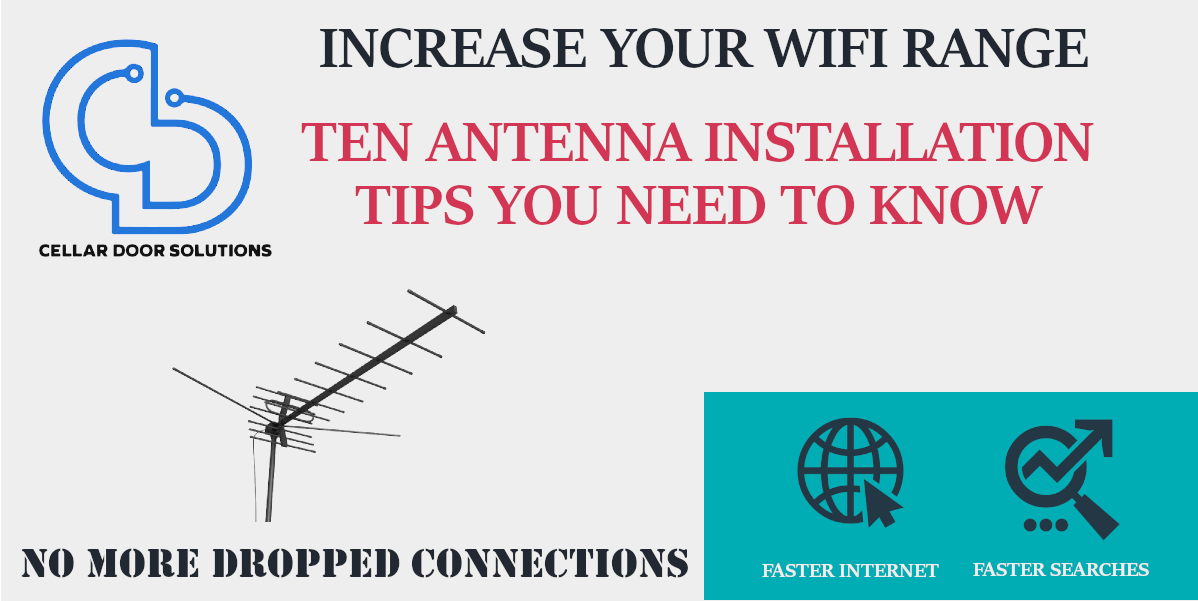Our job here at Cellar Door Solutions is to make your life easier. In this article we are going to discuss some tips on Antenna Mounting and Antenna Installation. We know that the topic seems boring but bear with us! That’s because mounting an Antenna properly is one of the most important things that you can do to improve your signal strength and increase your wireless reliability.
What is a Antenna??
In general a Antenna is just a device that is used to transmit and receive electromagnetic waves. Electromagnetic waves are often known as radio waves. Most antennas are “resonant devices”, which means that they work best in a very narrow frequency band. So before we go over the installation process make sure you purchase an antenna that is rated to transmit at the frequency you need! Also, some Antennas need to be tuned to the frequency band of the same radio system with which it is connected; if it does not happen signal strength can be diminished.
So now that you have the right antenna for the job and have it tuned to the right frequency lets go over some quick installation tips
Antenna Installation: Top Ten Tips
Tip 1 – You want a clear path for RF that is free of obstructions. Install antennas in such a way where they can “see” each other as much as possible. This is also known as Line of Sight or LOS in the industry. Typically speaking antennas can go significantly farther if they are aligned and have LOS between the antennas. In cases where the antennas are going to be very far away from each other (over 10 miles), we need to take into account the curvature of the earth! The antennas will have to be mounted high above the ground to compensate.
Tip 2 – In cases where the antennas are directional, you must pay attention to the antenna alignment. You need to double-check that the antennas are aligned to the center of the signal path and its corresponding angle and on the same level plane.
Tip 3 – Have an idea of the overall signal gain required based on the distance before mounting the antenna. The more the distance between the radios, the more the overall system gain needs to be. A good rule-of-thumb for the overall system gains vs. distance is as below:
Tip 4 – Try to minimize the number of connectors and antenna length between the transmitter and the antenna. The longer the antenna cable and the more the number of connections, the more the signal loss. Having a lot of connectors requires a better antenna gain to compensate for these losses and to meet the required distance. As a rule of thumb, the RF range will be reduced by half for every 6 dB signal loss. The lost signal has to be compensated by choosing a proper antenna gain. Most radio brands come standard with a cheap 3 dBi Omni whip antenna. In some cases, that’s enough, but in most cases, it’s not! If more gain is necessary, choose a higher gain antenna depending on your system requirement.
Tip 5 – Remember to try to use the minimum cable length required. Do not run more cable than needed!! Having a little extra is not a big deal, but in every cable, there is resistance and the more cable you have, the higher the resistance!!
Tip 6 – Try to avoid wrapping the cables or coiling the cables around anything. Coiling can create electromagnetic interference that can interfere with the signal strength!
Tip 7 – Use drip loops before entering the cabinet. This keeps moisture from collecting between the connection joints and in the cabinet itself. When using cabinets, bottom cable entry is recommended versus side entry. Never run the cable straight in through the top of your splicing box.
Tip 8 – Protect the antenna connection, with the rubberized electrical tape. If the antenna will be exposed to harsh conditions the use of die-electric grease can help prevent the connections to become oxidized and fail.
Tip 9 – When using directional antennas correctly phase the antenna with respect to the Omni base antenna. Make sure Yagis are phased (oriented) correctly with respect to the Omni base antenna
Tip 10 – DO NOT RUN YOUR ANTENNA CABLE IN THE SAME CONDUIT AS YOUR POWER CABLE. This is one of the most common mistakes I see out in the field. High powered electrical cable wreaks havoc on your antenna cables and can significantly reduce your signal strength. Keep the proper spacing between the cables.
